Emil Wikström
Emil Wikström | |
|---|---|
 Wikström in the 1930s | |
| Born | 13 April 1864 |
| Died | 26 September 1942 (aged 78) Helsinki, Finland |
| Nationality | Finnish |
| Known for | Sculpture |
Emil Wikström (13 April 1864 in Turku – 26 September 1942 Helsinki) was a Finnish sculptor. Among his best known works are the Lantern Carriers on the front of the Helsinki Central railway station and the monuments to Elias Lönnrot and Johan Vilhelm Snellman.[1]
Career[]


His parents were construction foreman Johan Erik Wikström and Gustava Samuelintytär Linnamäki.[1] Emil Wikström studied art in Finnish Art Association's drawing school in Turku and Helsinki, in the Academy of Fine Arts in Vienna and also in Académie Julian in Paris.[2] Wikström as well as other artists took inspiration for their art from their own country's cultural mythology. Finnish artists studied and worked in Paris. Some decided to retreat to the peace of forest, as Wikström wrote in a letter to Axel Gallén in 1898. Wikström was the first to carry out his plan and he found ideal place for himself in Sääksmäki by Vanajavesi.

Emil Wikström sculpted most of his work in , his home and studio in Valkeakoski.[3] Emil Wikström was the one of the most important Finnish sculptors of his time. Best remembered for his public monuments in Helsinki, the statues in railway station, and other cities across Finland, Wikström produced portraits of many statesmen, politicians, businessmen, family and friends, as well as figures from Finnish mythology.[1][4]

He is buried in the Hietaniemi Cemetery in Helsinki.[5]
Visavuori was opened to the public as a museum in 1967. There many of the original casts and studies are on display.[6]
Personal life[]
In 1890 he got engaged to painter Dora Wahlroos and they studied arts at Paris together. However they drifted apart and in 1895 Wikström married Alice Högström (1863–1950). They had three daughters: Estelle, Anna-Liisa and Mielikki Anne-Marie. Estelle's son Kari Suomalainen was a famous cartoonist,[1] and her daughter Saskia (a.k.a. Maaria Eira) was an opera singer and director.[7]
Works[]
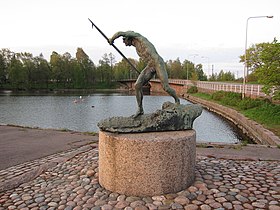
Log Driver
(the original sculpture is from 1890, and the photographed bronze copy from 1952) (fi)
Early design of the monument to Elias Lönnrot (winner of the 1899 design competition)
The complete Elias Lönnrot monument, 1902
(with Väinämöinen to his right and Impi to his left[8]) (fi)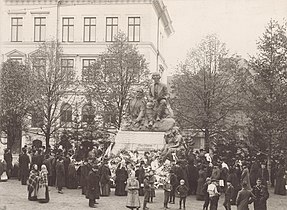
The statue of Lönnrot on the day of its reveal, 18 October 1902
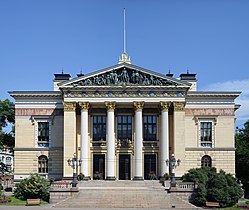
Tympanum of the House of Estates depicting Alexander I at the 1809 Diet of Finland, 1903[9]
Close-up of the tympanum

The original statue of Mikael Agricola in Vyborg, 1908
(lost in the Winter War[10]) (fi)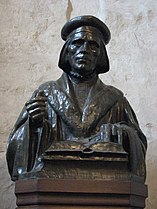
Bronze copy of the upper bust of Agricola in Turku, 1910
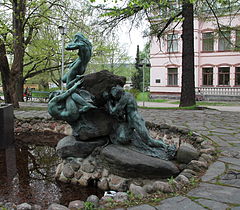
The fountain from the side (Aino is attempting to resist the call of the three water maidens of Vellamo, while a man of Ahtola is pushing the rock from behind[11])
The on the front of the Helsinki Central Station, 1914

Close-up of the Lantern Carriers

The Lantern Carriers illuminating the night in the 1970s

Monument to , 1921
Monument to Johan Vilhelm Snellman in front of the Bank of Finland, 1923
[note 1]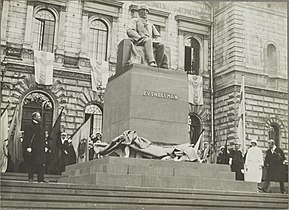
The unveiling of the statue of Snellman in 1923
(in fact already completed in 1916) (fi)
See also[]
Notes[]
- ^ Damaged in the bombings of the Continuation War, kept as it is.
References[]
- ^ Jump up to: a b c d Lindgren, Liisa (19 April 2017). "Wikström, Emil (1864 - 1942)". Kansallisbiografia. Retrieved 5 August 2020.
- ^ "Emil Wikström (1864-1942)". Visavuori. Retrieved 6 August 2020.
- ^ Friman, Terhi (20 August 2001). "Emil Wikström veisti Visavuoren maisemissa". Helsingin Sanomat. Retrieved 6 August 2020.
- ^ "Emil Wikström CV" (PDF). Visavuori. Retrieved 6 August 2020.
- ^ "Hietaniemen hautausmaa – merkittäviä vainajia" (PDF). Helsingin seurakuntayhtymä. Retrieved 27 August 2016.
- ^ Lehtinen, Nina (17 May 2018). "Emil Wickström oli aikansa menestynein julkisten taideteosten tekijä". Aamulehti. Retrieved 6 August 2020.
- ^ "Maaria Eira" (in Finnish). Helsingin Sanomat. 19 June 1999. Retrieved 15 March 2021.
- ^ "Emil Wikström -veistoskierros" (PDF). Helsinki Art Museum. Retrieved 5 August 2020.
- ^ Järvenpää, Eeva (1 October 2005). "Veistos tuotiin päätykolmioon salaa". Helsingin Sanomat. Retrieved 6 August 2020.
- ^ Sarmas, Iiris (24 November 2017). "Emil Wikström suomalaisuuden ytimessä". Agricola-verkko. Retrieved 6 August 2020.
- ^ "Kapteeni ja Rullatehtaan Aino - Aikamatka kaupungin juurille" (PDF). Ainopuiston Teatteri. Retrieved 6 August 2020.
- ^ "Näsikallion suihkukaivo". Tampere Art Museum. Retrieved 6 August 2020.
External links[]
| Wikimedia Commons has media related to Emil Wikström. |
- 1864 births
- 1942 deaths
- People from Turku
- Academy of Fine Arts Vienna alumni
- 20th-century Finnish sculptors
- 19th-century Finnish sculptors
- Burials at Hietaniemi Cemetery
- Finnish artist stubs
- European sculptor stubs
















